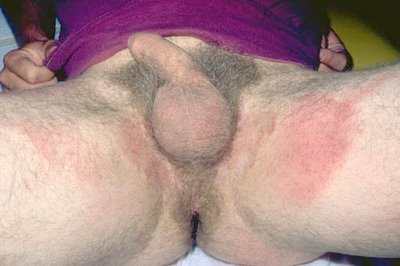Tinea cruris
| Tinea cruris | |
| ICD-10 | B35.6 |
|---|---|
| ICD-9 | 110.3 |
| DiseasesDB | 29140 |
| MedlinePlus | 000876 |
| eMedicine | derm/471 |
|
WikiDoc Resources for Tinea cruris |
|
Articles |
|---|
|
Most recent articles on Tinea cruris Most cited articles on Tinea cruris |
|
Media |
|
Powerpoint slides on Tinea cruris |
|
Evidence Based Medicine |
|
Clinical Trials |
|
Ongoing Trials on Tinea cruris at Clinical Trials.gov Clinical Trials on Tinea cruris at Google
|
|
Guidelines / Policies / Govt |
|
US National Guidelines Clearinghouse on Tinea cruris
|
|
Books |
|
News |
|
Commentary |
|
Definitions |
|
Patient Resources / Community |
|
Patient resources on Tinea cruris Discussion groups on Tinea cruris Patient Handouts on Tinea cruris Directions to Hospitals Treating Tinea cruris Risk calculators and risk factors for Tinea cruris
|
|
Healthcare Provider Resources |
|
Causes & Risk Factors for Tinea cruris |
|
Continuing Medical Education (CME) |
|
International |
|
|
|
Business |
|
Experimental / Informatics |
Overview
Tinea cruris is the scientific name for fungal infection of the groin region. Official alternative names include Jock itch or dhobi itch (after Indian washermen).
Diagnosis
Common Causes
Opportunistic infections (infections that are caused by a diminished immune system) are frequent. Fungus from other parts of the body (commonly tinea pedis or 'athlete's foot') can contribute to jock itch. A warm, damp environment allowing the fungus to cultivate greatly contributes; especially with tight, sweaty or rubbing clothing such as jockstrap or tight undershorts.
The type of fungus that most commonly causes tinea cruris is called Trichophyton rubrum. Some other contributing fungi are Candida albicans, Trichophyton mentagrophytes and Epidermophyton floccosum.
Symptoms and signs
As the common name for this condition implies, it causes itching or a burning sensation in the groin area, thigh skin folds, or anus. It may involve the inner thighs and genital areas, as well as extending back to the perineum and perianal areas.
Affected areas may appear red, tan, or brown, with flaking, peeling, or cracking skin.[1][2]
The acute infection begins with an area in the groin fold about a half-inch across, usually on both sides. The area may enlarge, and other sores may develop in no particular pattern. The rash appears as raised red plaques (platelike areas) and scaly patches with sharply defined borders that may blister and ooze.[3]
If the rash advances, it usually advances down the inner thigh. The advancing edge is redder and more raised than areas that have been infected longer. The advancing edge is usually scaly, and very easily distinguished or well demarcated.
The skin within the border turns a reddish-brown and loses much of its scale. The border may exhibit tiny pimples or even pustules, with central areas that are reddish and dry with small scales.[4][5]
If infected with candidal organisms, the rash tends to be redder and wetter. The skin of the penis may be involved, whereas other organisms spare the penis.
Physical Examination
Skin

Treatment
Tinea cruris is best treated with antifungal drugs applied topically. Traditionally creams containing clotrimazole or miconazole have been used, although newer agents such as butenafine are also used. These anti-fungal agents work by stopping the fungi from producing a substance called ergosterol, which is an essential component of fungal cell membranes. If ergosterol synthesis is completely or partially inhibited, the cell is no longer able to construct an intact cell membrane. This leads to death of the fungus.
If the skin inflammation causes discomfort and itching, glucocorticoid steroids may be combined with the anti-fungal drug to help prevent further irritation due to the patient scratching the area. Apart from the quicker relief of symptoms, this also helps minimise the risk of secondary bacterial infection caused by the scratching. However steroids, if used alone, for fungal infections may exacerbate the condition.
See also
Reference
External links
- eMedicine Health
- MayoClinic - jock itch
- Links to jock itch pictures (Hardin MD/Univ of Iowa)
- How to Prevent Jock Itch with Rubbing Alcohol